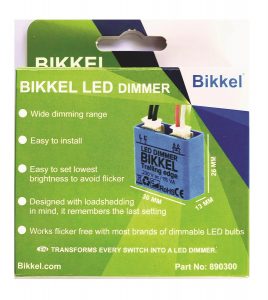Bikkel was started in 1997 to meet a gap in the market place for dimming lights, by Ruud De Vaal.
In 1998 the first patent was filed for a dimmer, which can be controlled by a conventional switch. Controlling the brightness of a light using a normal light switch was novel. Today it is still a standard feature of the Bikkel dimmer.
The Bikkel makes dimming of lights possible with two way switches without pulling any additional wiring.
The concept also allows the dimmer to be located at the lamp itself which opened up opportunities for OEM’s to incorporate a dimmer in their lamp fitting.
The replacement of the conventional inductor in the dimmer by a semiconductor device, took away the buzzing noise that the dimmers of the day had. This invention made a spectacular reduction in overall size of the dimmer possible. The Bikkel, still today, is regarded one of the smallest dimmers in the world.
In the early days the Bikkel was based on “leading edge” technology, which is are used for incandescent bulbs, as well as halogen lighting. LEDs bulbs gained popularity in the early 2015’s and this led to the demand for trailing edge dimmers.
In 2016 Bikkel developed a trailing edge dimmer. This was a development from the ground up, as LED bulbs, introduced their own challenges like flicker and compatibility issues.
In 2017 Bikkel and its partners around the world started a program to collect LED bulbs from every corner of the globe. All these were scrutinized and used in the development of the new trailing edge Bikkel dimmer. The result was one of the most LED compatible dimmers in the world without sacrificing dimming range and user-friendliness.
With the power outages in South Africa and Portugal, it was brought early to our attention, that power interruptions and load shedding for example is a part of life in some countries. We are proud to claim that Bikkel is the first dimmer in the world, which operates, after a power interruption, the way it operated before such interruption occurred. This sounds like a logical feature, but there are still many dimmers sold in the market which stay off or go to some fixed brightness, when the power is restored. This causes irritation for the consumers.
Working with LEDs formed a big part of Bikkel’s history. As the brightness reached higher levels, new applications were found. One of them are growlights. The prospects of energy savings compared to HPS lighting has made LED lights an interesting proposition.



Copyright © 2022 – Bikkel – Designer: The Executive Connection